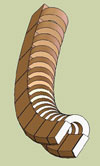U-Flex if you want to
 I've always said that to be a good engineer takes many years of experience but to be a great one takes an appreciation of history as well. It's a well-documented fact that very little is totally new in the world of automotive technology. For instance, four-valve chambers were first recorded in the Peugeot L3 of 1913, while the very first turbocharger came about in the mid-1920s - just two examples that readily spring to mind and were readily 're-invented' later in the century. So when people talk about the latest in oil control ring (OCR) technologies as being the U-Flex design, then sadly I have to shake my head in despair.
I've always said that to be a good engineer takes many years of experience but to be a great one takes an appreciation of history as well. It's a well-documented fact that very little is totally new in the world of automotive technology. For instance, four-valve chambers were first recorded in the Peugeot L3 of 1913, while the very first turbocharger came about in the mid-1920s - just two examples that readily spring to mind and were readily 're-invented' later in the century. So when people talk about the latest in oil control ring (OCR) technologies as being the U-Flex design, then sadly I have to shake my head in despair.
The basic U-flex design goes back many years. A one-piece OCR consisting of a complicated U-shaped pressing, the design was widely used even before World War II. The story I was told was that during the Great Depression of the 1930s, being unable to afford to replace their increasingly smoky and worn-out engines, an OCR was developed that conformed better to the these worn-out bores and kept the engines running when other OCRs did not.
While this might be an urban myth, the technology soon became unnecessary as bore technology improved, but the fact remains that designs like this produced exceptionally good oil control. But this was to the detriment of other characteristics.
All OCRs are now generally very good. Available as two- or even three-piece designs, they are configured to apply an even pressure around the bore as they travel up and down. When bores remain round and cylindrical they work very well, even though the radial pressures of the rings have to be higher than those of the compression rings above to compensate for the lack of exhaust gas pushing them out.
But as engines get lighter, cylinder walls thinner, or bores get closer together, these bores begin to distort and the traditional two- or three-piece ring becomes inadequate. Under such conditions the traditional approach does not work, so much more flexible oil rings are needed. As bores distort as a result of reduced cooling efficiency or greater loading due to lighter structures, U-Flex OCRs can therefore show great benefits. But even when distortion is under control, the design can still have advantages.
In any engine the piston ring pack can account for the lion's share of internal friction - 30%, sometimes as much as 50% of the total friction in an engine - and the vast majority can be down to the OCR. Traditional two- and three-piece designs are heavily tensioned to conform to the shape of the bore and therefore create high levels of friction.
The latest U-Flex, however, with its multi-segmented design, will conform to the bore more readily and so the potential exists to reduce this radial ring load. But, functioning much like a gapless one-piece design punched from spring steel and folded to suit, the accuracy has to be very high and matched to the bore if even higher, unintended, radial loads are to be avoided.
In high-revving engines, piston suppliers report poor support around the ring groove, and while the ring gives excellent conformability and minimal oil consumption, wear can be high. But like the great number of different piston ring designs before it, this, the latest in U-Flex designs, will no doubt have its place among the piston ring options.
Fig. 1 - CAD rendering of a U-Flex OCR
Written by John Coxon